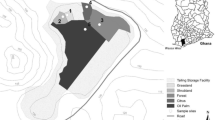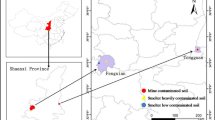Abstract
The heavy metal contamination in soils and cultivated corn plants affected by zinc smelting activities in the vicinity of a zinc smelting factory in Korea was studied. Soils and corn plants were sampled at the harvesting stage and analyzed for cadmium (Cd) and zinc (Zn) concentration, as well as Cd and Zn fraction and other chemical properties of soils. Cd and Zn were highly accumulated in the surface soils (0–20 cm), at levels higher than the Korean warning criteria (Cd, 1.5; Zn, 300 mg kg−1), with corresponding mean values of 1.7 and 407 mg kg−1, respectively, but these metals decreased significantly with increasing soil depth and distance from the factory, implying that contaminants may come from the factory through aerosol dynamics (Hong et al., Kor J Environ Agr 26(3):204–209, 2007a; Environ Contam Toxicol 52:496–502, 2007b) and not from geological sources. The leaf part had higher Cd and Zn concentrations, with values of 9.5 and 1733 mg kg−1, compared to the stem (1.6 and 547 mg kg−1) and grain (0.18 and 61 mg kg−1) parts, respectively. Cd and Zn were higher in the oxidizable fraction, at 38.5% and 46.9% of the total Cd (2.6 mg kg−1) and Zn (407 mg kg−1), but the exchangeable + acidic fraction of Cd and Zn as the bioavailable phases was low, 0.2 and 50 mg kg−1, respectively. To study the reduction of plant Cd and Zn uptake by liming, radish (Raphanus sativa L.) was cultivated in one representative field among the sites investigated, and Ca(OH)2 was applied at rates of 0, 2, 4, and 8 mg ha−1. Plant Cd and Zn concentrations and NH4OAc extractable Cd and Zn concentrations of soil decreased significantly with increasing Ca(OH)2 rate, since it markedly increases the cation exchange capacity of soil induced by increased pH. As a result, liming in this kind of soil could be an effective countermeasure in reducing the phytoextractability of Cd and Zn.




Similar content being viewed by others
References
Adriano DC (2001) Trace elements in terrestrial environments; biogeochemistry, bioavailability and risks of metals, 2nd edn. Springer, New York
Allison LE (1965) Organic carbon. In: Black CA (ed) Methods of soil analysis, Part II. Am. Soc. Agron. Publ, Madison, WI, pp 1367–1378
Andersson A, Siman G (1991) Levels of Cd and some other trace elements in soils and crops as influenced by lime and fertilizer level. Acta Agr Scand 41:3–11
Antoniadis V, Alloway BJ (2002) The role of dissolved organic carbon in the mobility of Cd, Ni and Zn in sewage sludge-amended soils. Environ Pollut 117:515–521. doi:10.1016/S0269-7491(01)00172-5
Basta NT, Sloan JJ (1999) Bioavailability of heavy metals in strongly acidic soils treated with exceptional quality biosolids. J Environ Qual 28:633–638
Basta NT, Gradwohl R, Snethen KL, Schroder JL (2001) Chemical immobilisation of lead, zinc and cadmium in smelter contaminatedsoils using biosolids and rock phosphate. J Environ Qual 30:1222–1230
Bolan NS, Naidu R, Khan MAR, Tillman RW, Syers JK (1999) The effects of anion sorption on sorption and leaching of cadmium. Aust J Soil Res 37:445–460. doi:10.1071/S97046
Bolan NS, Adriano DC, Mani PA, Duraisamy A (2003a) Immobilization and phytoavailability of cadmium in variable charge soils. II. Effect of lime addition. Plant Soil 251:187–198. doi:10.1023/A:1023037706905
Bolan NS, Adriano DC, Duraisamy A, Mani PA (2003b) Immobilization and phytoavailability of cadmium in variable charge soils. III. Effect of biosolid compost addition. Plant Soil 256:231–241. doi:10.1023/A:1026288021059
Bouyoucos GJ (1936) Directions for making mechanical analysis of soils by the hydrometer method. Soil Sci 4:225–228
Bowen HJM (1979) Environmental chemistry of the elements. Academic Press, New York
Brun LA, Maillet J, Hinsinger P, Pepin M (2001) Evaluation of copper availability to plants in copper-contaminated vineyard soils. Environ Pollut 111:293–302. doi:10.1016/S0269-7491(00)00067-1
Chen HM, Zheng CR, Tu C, Shen ZG (2000) Chemical methods and phytoremediation of soil contaminated with heavy metals. Chemosphere 41:229–234. doi:10.1016/S0045-6535(99)00415-4
Chlopecka A, Adriano DC (1996) Mimicked in-situ stabilization of metals in cropped soil: bioavailability and chemical form of zinc. Environ Sci Technol 30:3294–3303. doi:10.1021/es960072j
Chon HT, Ahn JS, Jung MC (1997) Environmental contamination of toxic heavy metals in the vicinity of some Au–Ag mines in Korea. In: Proceedings of the 4th Biennial SGA Meeting, Turku, Finland, pp 891–894
Codex Alimentarius Commission (1984) Contaminants, Joint FAO/WHO Food Standards Program. Vol XVII. 1st edn. Codex Alimentarius
Dahmain-Muller H, Oort FV, Gelie B, Bababane M (2000) Strategies of heavy metal uptake by the three species growing in a new metal smelter. Environ Pollut 109:231–238. doi:10.1016/S0269-7491(99)00262-6
Dudka S, Piotrowska M, Chlopecka A (1994) Effect of evelvated concentratios of Cd and Zn in soil on spring wheat yield and the metal contents of the plants. Water Air Soil Pollut 76:33–341. doi:10.1007/BF00482710
Gommy C, Perdrix E, Galloo JC, Guillermo R (1998) Metal speciation in soil: extraction of exchangeable cations from a calcareous soil with a magnesium nitrate solution. Int J Environ Anal Chem 72:27–45. doi:10.1080/03067319808032642
Granato TC, Pietz RI, Knafl GJ, Carlson CR, Tata JP, Lue-Hing C (2004) Trace element concentrations in soil, corn leaves, and grain after cessation of biosolids applications. J Environ Qual 33:2078–2089
Hamon RE, Lorenz SE, Holm PE, Christensen TH, McGrath SP (1995) Changes in trace metal species and other components of the rhizosphere during growth of radish. Plant Environ 18:749–756. doi:10.1111/j.1365-3040.1995.tb00577.x
Hong CO, Gutierrez JM, Lee SB, Lee YB, Yu C, Kim PJ (2007a) Determination of cadmium and zinc contamination source in arable soil in the vicinity of a zinc smelting factory. Kor J Environ Agr 26(3):204–209
Hong CO, Lee DK, Chung DY, Kim PJ (2007b) Liming effects on cadmium stabilization in upland soil affected by gold mining activity. Environ Contam Toxicol 52:496–502. doi:10.1007/s00244-006-0097-0
Hong CO, Lee DK, Kim PJ (2008) Feasibility of phosphate fertilizer to immobilize cadmium in a field. Chemosphere 70:2009–2015. doi:10.1016/j.chemosphere.2007.09.025
Jung MC (2001) Heavy metal contamination of soils and waters in and around the Imcheon Au-Ag mine, Korea. Appl Geochem 16:1377–1386. doi:10.1016/S0883-2927(01)00040-3
Jung MC, Thornton I (1996) Heavy metal contamination of soils and plants in the vicinity of a lead-zinc mine, Korea. Appl Geochem 11:53–59. doi:10.1016/0883-2927(95)00075-5
Knox AS, Seaman JC, Mench MJ, Vangronsveld J (2000) Remediation of metal and radionuclides-contaminated soils by in situ stabilization techniques. In: Iskander IK (ed) Environmental restoration of metals-contaminated soils. Lewis, New York, pp 21–60
Lee SH (2006) Geochemistry and partitioning of trace metals in paddy soils affected by metal mine tailings in Korea. Geoderma 135:26–37. doi:10.1016/j.geoderma.2005.11.004
Liu H, Probst A, Liao B (2005) Metal contamination of soils and crops affected by the Chenzhon lead/zinc mine spill (Hunan, China). Sci Total Environ 339:153–166. doi:10.1016/j.scitotenv.2004.07.030
ME (Ministry of Environment, Republic of Korea) (2005) The Korean Soil Environmental Conservation Act. ME, Gwacheon (in Korean)
Miller RW, Al-Khazraji ML, Sisson DR, Gardiner DT (1995) Alfalfa growth and absorption of cadmium and zinc from soils amended with sewage sludge. Agr Ecosyst Environ 53:179–184. doi:10.1016/0167-8809(94)00559-W
Naidu R, Bolan NS, Kookana RS, Tiller KG (1994) Ionic strength and pH effects on the adsorption of cadmium and the surface charge of soils. Eur J Soil Sci 45:419–429. doi:10.1111/j.1365-2389.1994.tb00527.x
NIAST (National Institute of Agricultural Science and Technology, Korea) (1997) Survey of heavy metals contamination degree of arable soil located in mining area. Annual Report. Department of Agricultural Environment, pp 237–243 (in Korean)
Pierzynski GM, Schwab AP (1993) Bioavailability of zinc, cadmium and lead in a metal contaminated alluvial soil. J Environ Qual 22:247–254
Pueyo M, Rauret G, Luck D, Yli-Halla M, Muntau H, Ph Quevauviller, Lopez-Sanchez JF (2001) Certification of the extractable contents of Cd, Cr, Cu, Ni, Pb and Zn in a freshwater sediment following a collaboratively tested and optimized three-step sequential extraction procedure. J Environ Monit 3:243–250. doi:10.1039/b010235k
RDA (Rural Development Administration, Korea) (1988) Methods of soil chemical analysis. National Institute of Agricultural Science and Technology, RDA, Suwon (in Korean)
RDA (1999) Recommendation standard of fertilization for crops. National Institute of Agricultural Science and Technology, RDA, Suwon (in Korean)
SAS Institute Inc (2001) User’s guide: statistics SAS version 8.2. SAS Institute, Cary, NC
Schofield RK (1949) Effect of pH on electric charges carried by clay particles. J Soil Sci 1:1–8. doi:10.1111/j.1365-2389.1950.tb00713.x
Sposito F, Sund LJ, Chang AC (1982) Trace metal chemistry in arid-zone field soils amended with sewage sludge: fractionation of Ni, Cu, Zn, Cd and Pb in solid phases. Soil Sci Soc Am J 46:260–264
Uminska R (1993) Cadmium contents of cultivated soils exposed to contamination in Poland. Environ Geochem Health 15:15–19. doi:10.1007/BF00146288
Ure AM, Quevauviller PH, Muntau H, Griepink B (1993) Speciation of heavy metals in soils and sediments. An account of the improvement and harmonization of extraction techniques undertaken under the auspices of the BCR of the Commission of the European Communities. J Environ Anal Chem 51:135–151. doi:10.1080/03067319308027619
Vallee BL, Auld DS (1990) Zinc coordination, function, and structure of zinc enzymes and other proteins. Biochemistry 29:5647–5659. doi:10.1021/bi00476a001
Xian X (1989) Effect of chemical forms of cadmium, zinc and lead in polluted soils on their uptake by cabbage plants. Plant Soil 113:257–264. doi:10.1007/BF02280189
Author information
Authors and Affiliations
Corresponding authors
Rights and permissions
About this article
Cite this article
Hong, C.O., Gutierrez, J., Yun, S.W. et al. Heavy Metal Contamination of Arable Soil and Corn Plant in the Vicinity of a Zinc Smelting Factory and Stabilization by Liming. Arch Environ Contam Toxicol 56, 190–200 (2009). https://doi.org/10.1007/s00244-008-9195-5
Received:
Accepted:
Published:
Issue Date:
DOI: https://doi.org/10.1007/s00244-008-9195-5




